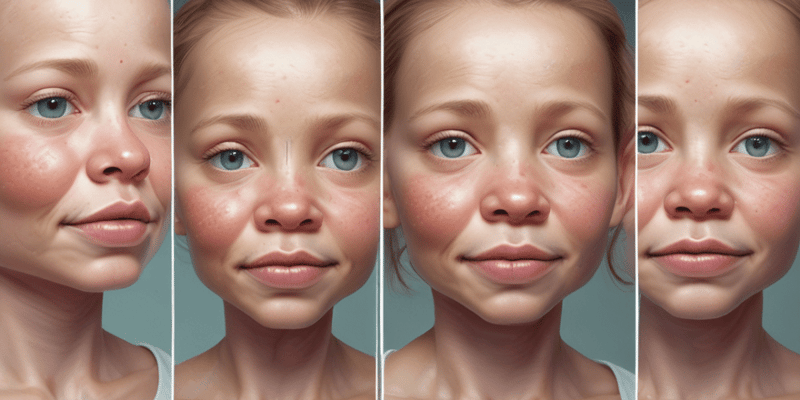Podcast
Questions and Answers
What is the primary cause of cleft lip and palate?
What is the primary cause of cleft lip and palate?
What developmental event leads to cleft palate?
What developmental event leads to cleft palate?
Which classification does NOT apply to cleft conditions?
Which classification does NOT apply to cleft conditions?
Which statement accurately reflects the classification of cleft lip and palate?
Which statement accurately reflects the classification of cleft lip and palate?
Signup and view all the answers
What is a critical factor in the development of cleft lip and palate according to inheritance patterns?
What is a critical factor in the development of cleft lip and palate according to inheritance patterns?
Signup and view all the answers
What defines a complete cleft lip and palate?
What defines a complete cleft lip and palate?
Signup and view all the answers
At what developmental stage is the failure of the tongue to drop critical for avoiding cleft palate?
At what developmental stage is the failure of the tongue to drop critical for avoiding cleft palate?
Signup and view all the answers
What is a potential consequence resulting from the failure of palatal shelves to fuse?
What is a potential consequence resulting from the failure of palatal shelves to fuse?
Signup and view all the answers
Which of the following is considered a characteristic of the secondary palate development?
Which of the following is considered a characteristic of the secondary palate development?
Signup and view all the answers
Which statement best describes the genetic aspect of cleft lip and palate?
Which statement best describes the genetic aspect of cleft lip and palate?
Signup and view all the answers
Study Notes
Cleft Lip and Palate: Clinical Aspects
- Cleft lip and palate is the most common craniofacial malformation, accounting for 65% of all abnormalities affecting the head and neck.
- Cleft lip and palate arises due to the failure of fusion during the two stages of dentofacial development.
- The development of the secondary palate (hard and soft) involves the palatal shelves.
- The tongue lowers, and the shelves elevate towards the midline, typically occurring between the 7th and 8th weeks of intrauterine life.
- Failure of the tongue to drop, fusion of the shelves, or a breakdown in the fusion process can lead to cleft palate.
- Failure of the shelves to fuse results in cleft lip and/or alveolus.
Classification of Cleft Lip and Palate
- Primary palate clefts occur in front of the incisive foramen.
- Complete cleft palate directly communicates with the nasal cavity.
- Incomplete cleft palate involves a partial separation of the palate.
- Unilateral cleft lip affects one side of the lip.
- Bilateral cleft lip affects both sides.
Treatment of Cleft Lip and Palate
- Ante-natal care focuses on informing and counseling the parents about the condition.
- Postnatal care includes multidisciplinary management, involving plastic surgeons, orthodontists, speech therapists, and pediatricians.
-
Pre-surgical orthodontics involves using appliances to:
- Align the alveolar segments
- Improve arch form and coordination
- Create space for bone grafts
- Facilitate lip closure
- Prevent further skeletal discrepancies
Orthodontic Implications of Cleft Lip and Palate
- Alveolar bone defects
- Skeletal discrepancies
- Dental anomalies
- Narrow maxillary arch
- Crossbite
- Malocclusion
- Supernumerary teeth
- Missing teeth
- Hypoplastic teeth
- Ectopic teeth
- Delayed eruption
- Increased risk of periodontal disease
- Speech difficulties
Clinical Aspects of Cleft Lip and Palate
- Cleft lip and palate is the most common craniofacial malformation, accounting for 65% of all head and neck abnormalities.
- Cleft lip and palate are caused by a failure of fusion during the two stages of dentofacial development.
- The development of the secondary palate (hard and soft) involves the palatal shelves elevating towards the midline as the tongue lowers.
- This process occurs during the 7th and 8th weeks of intrauterine life.
- A failure of the tongue to drop, fusion of the shelves, or a breakdown of the joint can lead to a cleft palate.
- Incomplete fusion results in a cleft lip and/or alveolus.
- Cleft lip and palate are considered polygenic inheritance, meaning they are caused by multiple genes.
- A complete cleft palate communicates directly with the nasal cavity.
- An incomplete cleft palate does not communicate with the nasal cavity.
- A cleft lip can be unilateral or bilateral.
- Cleft lip and palate can be classified into primary and secondary palates based on the location of the cleft.
- The primary palate is located in front of the incisive foramen.
- Prenatal care for cleft lip and palate includes genetic counseling, advising the parents of the implications of surgery, and providing support during gestation.
- Postnatal care involves managing feeding difficulties, providing support to the parents, and coordinating treatment with other healthcare professionals.
- Pre-surgical orthodontics aim to improve feeding, facilitate speech, and prepare the palate for surgery.
- Pre-surgical orthodontics involves the use of appliances such as a palatal obturator, a nasoalveolar molding device, and a removable appliance with a palatal prosthesis.
- Pre-surgical orthodontics can also help correct the position of the tongue and maxillary arch.
- Cleft lip and palate can have significant orthodontic implications, impacting the growth and development of the dentition, alveolar bone, and facial structures.
- These individuals are often impacted by crowding, missing teeth, malocclusion issues, and problems with tooth eruption.
Studying That Suits You
Use AI to generate personalized quizzes and flashcards to suit your learning preferences.
Related Documents
Description
This quiz focuses on the clinical aspects of cleft lip and palate, the most common craniofacial malformation. It covers the developmental failures that lead to these conditions, their classifications, and associated physiological processes. Test your knowledge on this significant health topic.




